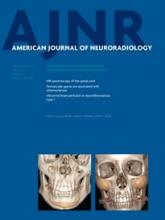Abstract
SUMMARY: Ganglionic eminence is the main transitory proliferative structure of the ventral telencephalon in human fetal brain and it contributes for at least 35% to the population of cortical interneurons; however data on the human GE anomalies are scarce. We report 5 fetal MR imaging observations with bilateral symmetric cavitations in their GE regions resembling an inverted open C shape and separating the GE itself form the deeper parenchyma. Imaging, neuropathology, and follow-up features suggested a malformative origin. All cases had in common characteristics of lissencephaly with agenesis or severe hypoplasia of corpus callosum of probable different genetic basis. From our preliminary observation, it seems that GE cavitations are part of conditions which are also accompanied by severe cerebral structure derangement.
ABBREVIATIONS:
- CC
- corpus callosum
- GA
- gestational age
- GE
- ganglionic eminence
- © 2013 by American Journal of Neuroradiology












